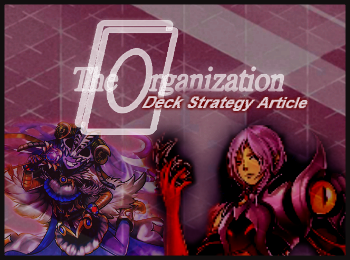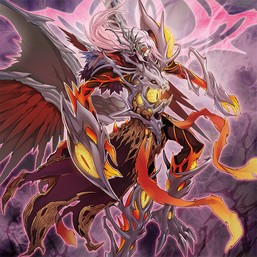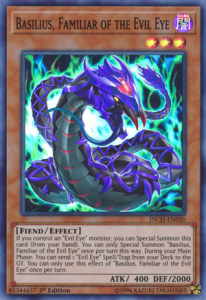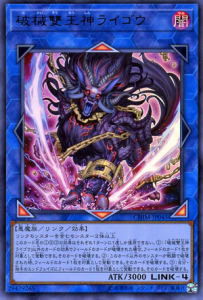In the Domain, anything goes… as long as you keep your Evil Eye on the prize.
Welcome to Pareidolia:
 The Domain of the Evil Eye empire is vast, with many fiendish strategies awaiting your exploitation. This archetype accomplishes so much with such a small monster suite, so I am very excited to be bringing you an article about them today, in the hopes that this may spur your Deck ideation and get those creative juices flowing. As a short introduction, the Evil Eye archetype is composed of DARK/Fiend monsters who span both Levels 3 and 4 and all revolve around a specific Equip Spell, Evil Eye of Selene (referred to as the Eye for the rest of this article). This Equip Spell grants protection from battle and card effects, as well as protection from targeting, in addition to a significant ATK/DEF boost for its equipped monster. That’s a lot, with only a slight cost to your LP each time you use another “Evil Eye” support card or the equipped monster’s effect. That being said, and as with any strategy that uses LP as a secondary resource, you should probably rethink the all-too common approach that ‘LP doesn’t matter until it hits 0‘ if you ever plan on piloting the Evil Eye. So let’s cluster this archetype into a couple sections, then we can dive into today’s Deckbuild and cool plays unique to this Deck.
The Domain of the Evil Eye empire is vast, with many fiendish strategies awaiting your exploitation. This archetype accomplishes so much with such a small monster suite, so I am very excited to be bringing you an article about them today, in the hopes that this may spur your Deck ideation and get those creative juices flowing. As a short introduction, the Evil Eye archetype is composed of DARK/Fiend monsters who span both Levels 3 and 4 and all revolve around a specific Equip Spell, Evil Eye of Selene (referred to as the Eye for the rest of this article). This Equip Spell grants protection from battle and card effects, as well as protection from targeting, in addition to a significant ATK/DEF boost for its equipped monster. That’s a lot, with only a slight cost to your LP each time you use another “Evil Eye” support card or the equipped monster’s effect. That being said, and as with any strategy that uses LP as a secondary resource, you should probably rethink the all-too common approach that ‘LP doesn’t matter until it hits 0‘ if you ever plan on piloting the Evil Eye. So let’s cluster this archetype into a couple sections, then we can dive into today’s Deckbuild and cool plays unique to this Deck.
The Watchers, Their Familliars, and the Rulers:
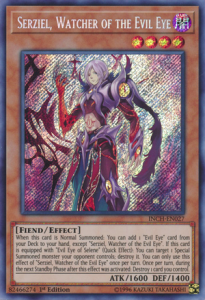 The first cluster of monsters I would like to discuss are the enablers of the Main Deck – the Watchers. Serziel, Watcher of the Evil Eye is first up on the list, and he is the bread, butter, and knife of your initial strategy. Similar to many other searchers such as Trickstar Candina, upon being Normal Summoned, Serziel lets you add any “Evil Eye” card from the Deck to your hand. But this is where the archetype starts to get super unique: Serziel also moonlights in the secondary role as being the Deck’s primary disruption. Whenever he is equipped with the Eye, Serziel gains a Quick Effect allowing him to target and destroy a Special Summoned monster your opponent controls. This allows you to interrupt your opponent’s Link chains, or even force your opponent’s negates much earlier than they intended to. Serziel’s final effect is designed to be a drawback, but you can also turn it into an advantage if you are savvy. The Standby Phase after using his Eye effect, you have to destroy 1 card you control. Yes, you can destroy the Eye if you must avoid taking damage, but there are many other options. The secondary (and far less important) watcher of the archetype is Medusa, Watcher of the Evil Eye. When she is Normal Summoned, she gets to return an “Evil Eye” card from the GY to the hand, so think of her as the reverse Serziel. Then, her Eye Quick Effect allows you to banish a monster from the opponent’s GY at will, which can be disruptive to many strategies. Lastly, her drawback banishes a card from your own GY, which is much less combo-friendly than that of Serziel. In short, she is a good card to have for the grind game, but a much less important piece of your overall strategy.
The first cluster of monsters I would like to discuss are the enablers of the Main Deck – the Watchers. Serziel, Watcher of the Evil Eye is first up on the list, and he is the bread, butter, and knife of your initial strategy. Similar to many other searchers such as Trickstar Candina, upon being Normal Summoned, Serziel lets you add any “Evil Eye” card from the Deck to your hand. But this is where the archetype starts to get super unique: Serziel also moonlights in the secondary role as being the Deck’s primary disruption. Whenever he is equipped with the Eye, Serziel gains a Quick Effect allowing him to target and destroy a Special Summoned monster your opponent controls. This allows you to interrupt your opponent’s Link chains, or even force your opponent’s negates much earlier than they intended to. Serziel’s final effect is designed to be a drawback, but you can also turn it into an advantage if you are savvy. The Standby Phase after using his Eye effect, you have to destroy 1 card you control. Yes, you can destroy the Eye if you must avoid taking damage, but there are many other options. The secondary (and far less important) watcher of the archetype is Medusa, Watcher of the Evil Eye. When she is Normal Summoned, she gets to return an “Evil Eye” card from the GY to the hand, so think of her as the reverse Serziel. Then, her Eye Quick Effect allows you to banish a monster from the opponent’s GY at will, which can be disruptive to many strategies. Lastly, her drawback banishes a card from your own GY, which is much less combo-friendly than that of Serziel. In short, she is a good card to have for the grind game, but a much less important piece of your overall strategy.
Next up on our archetype tour is the Familliars, otherwise known as the Link fodder with additional supportive effects. Catoblepas, Familiar of the Evil Eye is a Level 3 Fiend (Think Tour Guide) that can Special Summon itself from the GY whenever you control an Evil Eye monster, but it gets banished afterwards. This is a great card at just getting more Link fodder to your field, as the “Evil Eye” theme does not hurt for good Link Monsters to go into. Catoblepas also has the secondary effect of being able to protect a face-up “Evil Eye” Spell or Trap until the end of your opponent’s turn, which can be useful to protect the Eye protecting your Serziel – but honestly, this effect will not see much play, especially since Knightmare Unicorn exists. The second familiar (and the one that helps enable some sweet combos) is Basilius, Familiar of the Evil Eye. Similar to Catoblepas, whenever you control an Evil Eye, you can Special Summon Basil to the field, but from the hand. The supportive effect is the much more powerful one here, as you can send any “Evil Eye” Spell/Trap from the Deck to the GY, a la Foolish Burial Goods for the archetype. This is AMAZING on so many levels due to the support suite available to the deck, but it also allows for quick Link Summoning to get your gameplan off and rolling early on.
 Finally, we’ve arrived at the Rulers or the two boss monsters for the theme. First, you should note that any of the aforementioned monsters can easily become a boss by equipping the Eye to it then letting it grow in power, but these ones really take that up a notch. The first monster, Zerrziel, Ruler of the Evil Eyed, is a Link 3 that boasts a number of effects. First, if you used an “Evil Eye” monster with 2600+ ATK as material, it gets to attack twice. Pretty nice for a theme built around empowering a boss monster to insane ATK heights. Then, if you equip the Eye to him, he gets a Quick Effect to target and destroy any of your opponent’s cards. Again, more awesome disruption at your fingertips. Lastly, his drawback is to destroy a monster he points to during the following Standby Phase, which can also be your opponent’s monster, since he has one Up arrow. In short, this is a boss monster any beatstick archetype would love, but it also comes with additional disruption to ensure you can interrupt your opponent’s plays. The second Link Monster has not yet been released to the TCG, but will be coming soon in the next core booster set: Gorgoné, Queen of the Evil Eyed (YGOrg translation) is a Link 2 boss monster that gains attack for each “Evil Eye” card in your GY, as well as the Eye Quick Effect to negate the effects of a face-up monster. At face value, Zerrziel seems like a much better boss monster, but Gorgoné’s strength is that she gives an in-theme Down arrow, giving an easy co-link arrow for your “Knightmare” Link Monsters. That starts the advantage train chugging right along.
Finally, we’ve arrived at the Rulers or the two boss monsters for the theme. First, you should note that any of the aforementioned monsters can easily become a boss by equipping the Eye to it then letting it grow in power, but these ones really take that up a notch. The first monster, Zerrziel, Ruler of the Evil Eyed, is a Link 3 that boasts a number of effects. First, if you used an “Evil Eye” monster with 2600+ ATK as material, it gets to attack twice. Pretty nice for a theme built around empowering a boss monster to insane ATK heights. Then, if you equip the Eye to him, he gets a Quick Effect to target and destroy any of your opponent’s cards. Again, more awesome disruption at your fingertips. Lastly, his drawback is to destroy a monster he points to during the following Standby Phase, which can also be your opponent’s monster, since he has one Up arrow. In short, this is a boss monster any beatstick archetype would love, but it also comes with additional disruption to ensure you can interrupt your opponent’s plays. The second Link Monster has not yet been released to the TCG, but will be coming soon in the next core booster set: Gorgoné, Queen of the Evil Eyed (YGOrg translation) is a Link 2 boss monster that gains attack for each “Evil Eye” card in your GY, as well as the Eye Quick Effect to negate the effects of a face-up monster. At face value, Zerrziel seems like a much better boss monster, but Gorgoné’s strength is that she gives an in-theme Down arrow, giving an easy co-link arrow for your “Knightmare” Link Monsters. That starts the advantage train chugging right along.
 So we’ve met the monsters, but what about the support cards? In short, the Evil Eye archetype is well supported by a suite of Spell and Trap cards. First up you have Evil Eye Awakening, a simple extender that can summon an Evil Eye from the hand or from your GY. This is a quick and easy way to get more Link plays going, but if you happen to already have your Eye faceup, you can choose to Special Summon straight from the Deck instead! More tutoring is always a yay in my book. Evil Eye Repose has three different effects, each helping with a different phase of a typical Duel. The first effect lets you dig deeper into your deck for free, giving you a draw at virtually no cost. The second effect lets you threaten boss monsters with any battle, as long as you have your Eye equipped to a monster. And the final effect makes it a viable target for Serziel’s drawback effect, refilling your GY for more Eye banishing shenanigans or recycling your Catoblepas and Evil Eye of Gorgoneion (YGOrg Translation). Speaking of your backup eye, Gorgoneion is it! Instead of granting protection, this Eye gives your monsters bonus stats for every 100 LP you are behind your opponent. More importantly, you can banish this Eye from the GY and discard an “Evil Eye” card to get any of your “Evil Eye” Spells or Traps to the hand. While Domain and Serziel may already be the best searchers you could ask for in a flat archetype like this, Gorgonenion got all of your other searching needs covered, while also getting your dead drawn Catoblepas into the GY where he belongs. In terms of traps, the archetype also has a suite of disruptive traps that can bounce monster(s) to hand (Evil Eye Defeat), take control of monsters (Evil Eye Mesmerism), or negate Spells/Traps (Evil Eye Retribution). These folks just add to the disruptive capabilities of Serziel, giving more headaches to your poor opponents trying to figure out how to play through your disruption. But that’s enough about the archetype, let’s take a look at the sample deck and talk about some of the supporting cast.
So we’ve met the monsters, but what about the support cards? In short, the Evil Eye archetype is well supported by a suite of Spell and Trap cards. First up you have Evil Eye Awakening, a simple extender that can summon an Evil Eye from the hand or from your GY. This is a quick and easy way to get more Link plays going, but if you happen to already have your Eye faceup, you can choose to Special Summon straight from the Deck instead! More tutoring is always a yay in my book. Evil Eye Repose has three different effects, each helping with a different phase of a typical Duel. The first effect lets you dig deeper into your deck for free, giving you a draw at virtually no cost. The second effect lets you threaten boss monsters with any battle, as long as you have your Eye equipped to a monster. And the final effect makes it a viable target for Serziel’s drawback effect, refilling your GY for more Eye banishing shenanigans or recycling your Catoblepas and Evil Eye of Gorgoneion (YGOrg Translation). Speaking of your backup eye, Gorgoneion is it! Instead of granting protection, this Eye gives your monsters bonus stats for every 100 LP you are behind your opponent. More importantly, you can banish this Eye from the GY and discard an “Evil Eye” card to get any of your “Evil Eye” Spells or Traps to the hand. While Domain and Serziel may already be the best searchers you could ask for in a flat archetype like this, Gorgonenion got all of your other searching needs covered, while also getting your dead drawn Catoblepas into the GY where he belongs. In terms of traps, the archetype also has a suite of disruptive traps that can bounce monster(s) to hand (Evil Eye Defeat), take control of monsters (Evil Eye Mesmerism), or negate Spells/Traps (Evil Eye Retribution). These folks just add to the disruptive capabilities of Serziel, giving more headaches to your poor opponents trying to figure out how to play through your disruption. But that’s enough about the archetype, let’s take a look at the sample deck and talk about some of the supporting cast.
Decklist:
Monsters (16):
||| Serziel, Watcher of the Evil Eye
| Medusa, Watcher of the Evil Eye
||| Basilius, Familiar of the Evil Eye
|| Catoblepas, Familiar of the Evil Eye
||| Archfiend Eccentrick
| Archfiend Hieress
| Sangan
| Tour Guide from the Underworld
| Pendulumucho
Spells (21):
||| Evil Eye Domain – Pareidolia
||| Evil Eye Awakening
|| Evil Eye of Gorgoneion (YGOrg Translation)
|| Evil Eye of Selene
||| Evil Eye Repose
||| Falling Down
||| Foolish Burial Goods
| Foolish Burial
| TerraformingTraps (3):
| Evil Eye Defeat
| Evil Eye Mesmerism
| Evil Eye RetributionExtra Deck:
| Borrelsword Dragon
| Gorgoné, Queen of the Evil Eyed (YGOrg Translation)
| Hakai Sou-Oh-Shin Raigou (YGOrg Translation)
| Knightmare Cerberus
| Knightmare Gryphon
| Knightmare Mermaid
| Knightmare Phoenix
|| Knightmare Unicorn
|| Masterking Archfiend
| Underclock Taker
| Apollousa, Bow of the Goddess
| Zerrziel, Ruler of the Evil Eyed
| Leviair the Sea Dragon
Why did you include those tech cards?
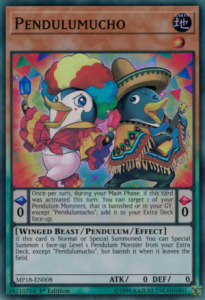 Yes, I’m serious by including them: there are plenty of reasons to include a small Archfiend suite. I personally love using it in any Fiend-type deck that aims to link summon frequently, just because there is that chance that you get lucky and get your material back for free advantage. But in this deck, it also serves a dual purpose, since you can trigger Masterking Archfiend‘s 2nd effect by recovering the Eye with its own GY effect. So for Evil Eye, it also provides searchable backrow disruption that you get while making your plays. Also, Falling Down is such a powerful card. All you need is a face-up Masterking or simply an Eccentrick in your Pendulum Zone!
Yes, I’m serious by including them: there are plenty of reasons to include a small Archfiend suite. I personally love using it in any Fiend-type deck that aims to link summon frequently, just because there is that chance that you get lucky and get your material back for free advantage. But in this deck, it also serves a dual purpose, since you can trigger Masterking Archfiend‘s 2nd effect by recovering the Eye with its own GY effect. So for Evil Eye, it also provides searchable backrow disruption that you get while making your plays. Also, Falling Down is such a powerful card. All you need is a face-up Masterking or simply an Eccentrick in your Pendulum Zone!
As for the other questionable choice – the random Pendulumucho. To be frank, I wanted a searchable low scale, and that’s what the little bird gave me. (Note that if you use Tour Guide from the Underworld into Sangan, you can still search with Sangan if you Link Summon with the little fluffball). As you’ll discover in the next couple sections, the odds of ending your opening turn with a free Eccentrick Archfiend are very high, so by including an additional low-scale Pendulum, I can actually enable Pendulum Summoning as a side option for the deck… especially due to the fact that constantly bringing back free monster destruction every turn definitely helps in a grind game.
Other Tech Options:
 Evil Eye Confrontation – This is a searchable MST for the archetype that banishes if you have Selene out on the field. I think Eccentrick is a strong enough backrow destruction choice on its own, but I have definitely wished I ran this when fighting decks like True King and Salamangreat.
Evil Eye Confrontation – This is a searchable MST for the archetype that banishes if you have Selene out on the field. I think Eccentrick is a strong enough backrow destruction choice on its own, but I have definitely wished I ran this when fighting decks like True King and Salamangreat.- Hand Traps – Feel free to throw all of the hand traps your heart desires in here. I preferred to stick to a streamlined build to maximize my Evil Eye combo potential, but if you want more disruption, this deck includes them well.
- Pot of Extravagance – This deck works well with this card, but if you choose to run it, running less copies of Repose and duplicates in your Extra Deck is an absolute must. If I was building a TCG-only version of Evil Eye at this point in time, I would go with this for sure in my build.
- Allure of Darkness – If you don’t like the risk the last draw card offers, this is a great backup. The whole archetype is DARK, so why not get to a Serziel equivalent faster?
- Viruses – Instead of opting as much into the Evil Eye trap lineup, you could run viruses instead, such as Full Force Virus or Crush Card Virus, because you can trigger them easily with either Basilius or a boosted Evil Eye via Selene. Just keep in mind the downsides of each.
- Fiend Griefing – Disrupt the opponent’s GY on the fly, as well as setting up a Cateblepas for your own.
- Burning Abyss – You can definitely choose to run a small Burning Abyss engine in this deck as well. As Graff and Farfa each have 1000 ATK, they could also be sent to the GY by Masterking when you pay for your Eye. This would also let you use Dante as the Rank 3 to keep your Catoblepas bouncing to and from your GY.
Opening Play Sequences can be Advantage-Positive with Masterking Archfiend:
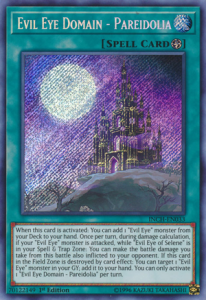 What you probably noticed so far about the Evil Eye archetype from my writeup so far is that it seems very flat and non-linear. A good example of this style of archetype is Spellbook – you have access to virtually any card in the archetype at any time, due to having multiple searchers and multiple power plays that can come out of each line of play available to you. So this means that you will always have an array of options available to you. Before going further, let’s dive into a bit of math quickly with this deck. Since the field spell, Evil Eye Domain – Pareidolia, can add any Evil Eye monster to hand, the equivalent of opening Serziel jumps to 7 cards (3 of each plus Terraforming). This means you have a 63.93% chance of opening a Serziel in your starting hand of 5 cards with a 40 card build. Below is a set of basic to advanced combos that you can do with the deck, revolving around Serziel, each with a probability of opening it because math is fun. As a note, we have featured in the past a probability calculator that can be quite useful – you can find it in our past article “Demystifying Probability 2” here. The actual probabilities are calculated using the deckbuild featured above, so make sure you note that if you adjust the deckbuild, the probabilities will change as well.
What you probably noticed so far about the Evil Eye archetype from my writeup so far is that it seems very flat and non-linear. A good example of this style of archetype is Spellbook – you have access to virtually any card in the archetype at any time, due to having multiple searchers and multiple power plays that can come out of each line of play available to you. So this means that you will always have an array of options available to you. Before going further, let’s dive into a bit of math quickly with this deck. Since the field spell, Evil Eye Domain – Pareidolia, can add any Evil Eye monster to hand, the equivalent of opening Serziel jumps to 7 cards (3 of each plus Terraforming). This means you have a 63.93% chance of opening a Serziel in your starting hand of 5 cards with a 40 card build. Below is a set of basic to advanced combos that you can do with the deck, revolving around Serziel, each with a probability of opening it because math is fun. As a note, we have featured in the past a probability calculator that can be quite useful – you can find it in our past article “Demystifying Probability 2” here. The actual probabilities are calculated using the deckbuild featured above, so make sure you note that if you adjust the deckbuild, the probabilities will change as well.
Unrestricted Start A: Serziel + any 4 other cards (69.93%):
Summon Serziel, using its effect to grab Domain (if you didn’t have to use it to get Serziel), then in either line of play, add Basilius to hand. Special Basilius, use its effect to send the Eye to the GY.
Unrestricted Start B: Serziel + any Evil Eye card + any 3 other cards (63.03%):
Summon Serziel, using its effect to grab Domain (if you didn’t have to use it to get Serziel), then in either line of play, add Basilius to hand. Special Basilius, use its effect to send Evil Eye of Gorgoneion (YGOrg Translation) to the GY. Use Gorgoneion’s GY effect, banishing itself and discarding other your Evil Eye card to add Evil Eye of Selene to hand. Equip the Eye to Serziel. End result: Serziel is online and ready to go with a face-up Domain.
Semirestricted Start A: Serziel + any Evil Eye Spell or Trap card + any 3 other cards (54.02% or 52.09%):
Summon Serziel, using its effect to grab Domain (if you didn’t have to use it to get Serziel), then in either line of play, add Basilius to hand. Special Basilius, use its effect to send Evil Eye of Gorgoneion (YGOrg Translation) to the GY. Use Gorgoneion’s GY effect, banishing itself and discarding your Evil Eye S/T to add Evil Eye of Selene to hand. Equip the Eye to Serziel. Next, you can Link Summon Masterking Archfiend. Use the eff of the Eye, banishing your other S/T and paying 1000 to set itself to the field, which triggers Masterking’s 2nd effect. Masterking then can send Archfiend Hieress to the GY, which then activates in a chain with Masterking’s 3rd effect. If you’re lucky, Hieress will be summoned to the field or added to your hand (for free extra advantage), but if you are not, you still add Eccentrick Archfiend to the hand. End result: You have a Masterking, a set Eye, a face-up Domain, and an Eccentrick in hand.
Semirestricted Start B: Serziel + Basilius + any 3 other cards (33.91%):
Summon Serziel (or first activate Domain to get Serz), using its effect to add Evil Eye Awakening to hand. Special Basilius, use its effect to send the Eye to the GY. Then, you can Link Summon Masterking Archfiend. Activate Awakening to Special Summon Serziel back to your field. Next, use the eff of the Eye, banishing your Awakening and paying 1000 to set itself to the field, which triggers Masterking’s 2nd effect. Masterking then can send Archfiend Hieress to the GY, which then activates in a chain with Masterking’s 3rd effect. If you’re lucky, Hieress will be summoned to the field or added to your hand (for free extra advantage), but if you are not, you still add Eccentrick Archfiend to the hand. Finally, equip your set Eye to Serziel. End result: You have a Masterking, a Serizel with an Eye, a face-up Domain, and an Eccentrick in hand.
Semirestricted Start C: Serziel + Evil Eye of Selene/Basilius/Evil Eye Awakening + any 3 other cards (49.89%):
This is actually the real probability of ending on the same result as Semirestricted Start B, since you can make a more complex play with any combo of Serz. If you started with Selene for example: Summon Serziel (or first activate Domain to get Serz), using its effect to add Basilius (or Domain to get Basilius) to hand. Special Basilius, use its effect to send the Evil Eye of Gorgoneion (YGOrg Translation) to the GY. Then, you can Link Summon Masterking Archfiend. Use Gorgoneion’s GY effect by banishing itself and discarding Eye of Selene, which then adds Evil Eye Awakening to hand. Activate Awakening to Special Summon Serziel back to your field. Next, use the eff of the Eye now in your GY, banishing your Awakening and paying 1000 to set itself to the field, which triggers Masterking’s 2nd effect. Masterking then can send Archfiend Hieress to the GY, which then activates in a chain with Masterking’s 3rd effect. If you’re lucky, Hieress will be summoned to the field or added to your hand (for free extra advantage), but if you are not, you still add Eccentrick Archfiend to the hand. Finally, equip your set Eye to Serziel. End result: You have a Masterking, a Serizel with an Eye, a face-up Domain, and an Eccentrick in hand.
Demystifying artifically lowered percentages?
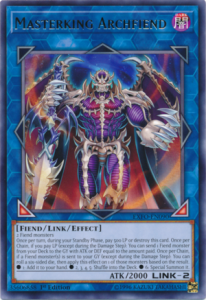 As you can hopefully tell – all of these plays are simply the beginning. You can extend further, do more creative things. Employ the other cards you draw. Additionally, there are even other unmentioned combos at our disposal to get to the starting Serziel you might need. For example, Foolish Burial Goods and any other Evil Eye card in hand can turn into your initial Pareidolia due to the GY effect of Gorgoneion. So at best, the probabilities above are lowball estimates. At the end of the day, the big takeaway for you as a reader about the Evil Eye archetype is that you have so many options at 1 and 2 card combos that simply give you extra advantage and more options going into the next turn if going first. Additionally, you should probably note that the field spell gives you a free Evil Eye back from your GY when it is destroyed by a card effect. So by ending on a Domain, either your opponent destroys it and gives you Serziel back to start it all again on the next turn, or they leave it for you to destroy with Serziel when his drawback swings around for the kill. In which case you just got a free Basilius back to hand and can start your next chain of summons. Even if both of those fail, the Archfiend Eccentrick that you search off of Masterking is your final advantage savant, being able to trigger that recovery in a pinch. Now let me be clear, this deck can also put up other end fields that don’t rely on Archfiend, and that’s the direction many folks have taken this deck in the past. But I contend that if you manage to get your Masterking Archfiend rolling the dice every single time you go for a link summon (which can be a lot), you always have a 33% chance of rolling favorably and getting one of those material monsters immediately back. That my friends is my secret to employing this archtype to great effect. Oh, and did you notice that most of these chains end after 4 summons, so Nibiru won’t wipe you once it crashes into the TCG soon?
As you can hopefully tell – all of these plays are simply the beginning. You can extend further, do more creative things. Employ the other cards you draw. Additionally, there are even other unmentioned combos at our disposal to get to the starting Serziel you might need. For example, Foolish Burial Goods and any other Evil Eye card in hand can turn into your initial Pareidolia due to the GY effect of Gorgoneion. So at best, the probabilities above are lowball estimates. At the end of the day, the big takeaway for you as a reader about the Evil Eye archetype is that you have so many options at 1 and 2 card combos that simply give you extra advantage and more options going into the next turn if going first. Additionally, you should probably note that the field spell gives you a free Evil Eye back from your GY when it is destroyed by a card effect. So by ending on a Domain, either your opponent destroys it and gives you Serziel back to start it all again on the next turn, or they leave it for you to destroy with Serziel when his drawback swings around for the kill. In which case you just got a free Basilius back to hand and can start your next chain of summons. Even if both of those fail, the Archfiend Eccentrick that you search off of Masterking is your final advantage savant, being able to trigger that recovery in a pinch. Now let me be clear, this deck can also put up other end fields that don’t rely on Archfiend, and that’s the direction many folks have taken this deck in the past. But I contend that if you manage to get your Masterking Archfiend rolling the dice every single time you go for a link summon (which can be a lot), you always have a 33% chance of rolling favorably and getting one of those material monsters immediately back. That my friends is my secret to employing this archtype to great effect. Oh, and did you notice that most of these chains end after 4 summons, so Nibiru won’t wipe you once it crashes into the TCG soon?
In terms of responding to an established board, Evil Eye also have a ton of options. Once Serziel is equipped with the Eye, your opponent will have a hard time outing him, so they will generally throw all of their negation at the Eye. The biggest thing to remember is that you always have alternate removal options as well. Whether it is going into a Cerberus co-linked to your Gorgoné to gain advantage while outing a threat, utilizing your backrow Evil Eye toolbox, or simply relying on Falling Down: you have options. And that’s important in the modern game.
Conclusion:
With that, I believe I’ve said all I have to say about this really neat archetype. The Evil Eye really do have their eye on securing the victory through any means, especially if it requires disrupting the opponent. I specifically love their ability to incorporate so much consistency into their plays as well. At the end of the day, I hope that this article might inspire you to try something new with an archetype you’ve noticed – there is plenty of potential out there for so many archetypes, maybe you could figure out how to build the next standout!
Reminder, I also take suggestions for future CDS articles! I really want to see some input from you! If you wish to see a CDS article about the archetype, theme, or strategy you love, feel free to private message me on the YGOrg Discord server, the YGOrganization Forums, or just post a comment in response to this article on our Facebook page with your ideas to keep under consideration. On most YGO-related communities my username is Quincymccoy, so feel free to reach out.

